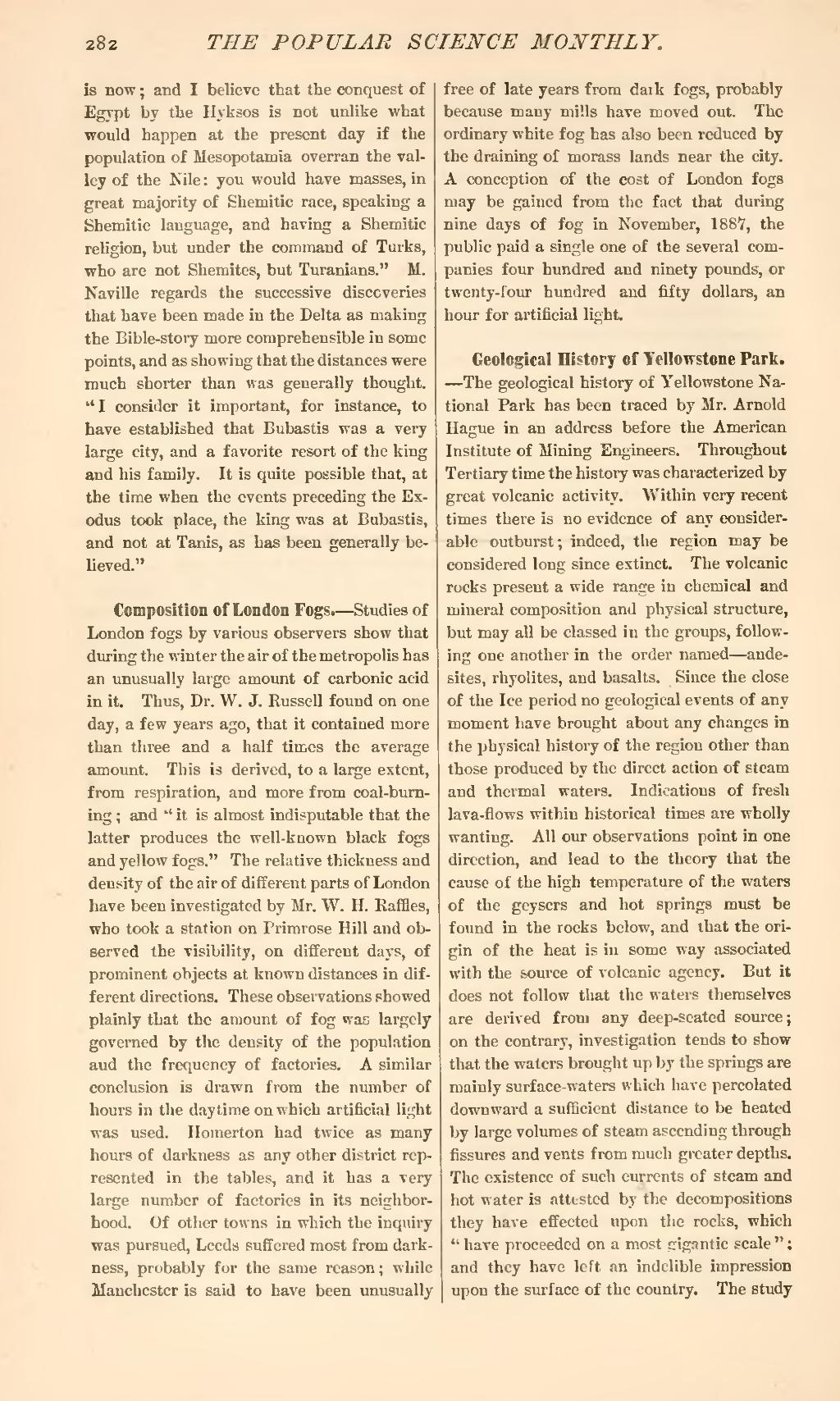is now; and I believe that the conquest of Egypt by the Hyksos is not unlike what would happen at the present day if the population of Mesopotamia overran the valley of the Nile: you would have masses, in great majority of Shemitic race, speaking a Shemitic language, and having a Shemitic religion, but under the command of Turks, who are not Shemites, but Turanians." M. Naville regards the successive discoveries that have been made in the Delta as making the Bible-story more comprehensible in some points, and as showing that the distances were much shorter than was generally thought. "I consider it important, for instance, to have established that Bubastis was a very large city, and a favorite resort of the king and his family. It is quite possible that, at the time when the events preceding the Exodus took place, the king was at Bubastis, and not at Tanis, as has been generally believed."
Composition of London Fogs.—Studies of London fogs by various observers show that during the winter the air of the metropolis has an unusually large amount of carbonic acid in it. Thus, Dr. W. J. Russell found on one day, a few years ago, that it contained more than three and a half times the average amount. This is derived, to a large extent, from respiration, and more from coal-burning; and "it is almost indisputable that the latter produces the well-known black fogs and yellow fogs." The relative thickness and density of the air of different parts of London have been investigated by Mr. W. H. Raffles, who took a station on Primrose Hill and observed the visibility, on different days, of prominent objects at known distances in different directions. These observations showed plainly that the amount of fog was largely governed by the density of the population and the frequency of factories. A similar conclusion is drawn from the number of hours in the daytime on which artificial light was used. Homerton had twice as many hours of darkness as any other district represented in the tables, and it has a very large number of factories in its neighborhood. Of other towns in which the inquiry was pursued, Leeds suffered most from darkness, probably for the same reason; while Manchester is said to have been unusually free of late years from dark fogs, probably because many mills have moved out. The ordinary white fog has also been reduced by the draining of morass lands near the city. A conception of the cost of London fogs may be gained from the fact that during nine days of fog in November, 1887, the public paid a single one of the several companies four hundred and ninety pounds, or twenty-four hundred and fifty dollars, an hour for artificial light.
Geological History of Yellowstone Park.—The geological history of Yellowstone National Park has been traced by Mr. Arnold Hague in an address before the American Institute of Mining Engineers. Throughout Tertiary time the history was characterized by great volcanic activity. Within very recent times there is no evidence of any considerable outburst; indeed, the region may be considered long since extinct. The volcanic rocks present a wide range in chemical and mineral composition and physical structure, but may all be classed in the groups, following one another in the order named—andesites, rhyolites, and basalts. Since the close of the Ice period no geological events of any moment have brought about any changes in the physical history of the region other than those produced by the direct action of steam and thermal waters. Indications of fresh lava-flows within historical times are wholly wanting. All our observations point in one direction, and lead to the theory that the cause of the high temperature of the waters of the geysers and hot springs must be found in the rocks below, and that the origin of the heat is in some way associated with the source of volcanic agency. But it does not follow that the waters themselves are derived from any deep-seated source; on the contrary, investigation tends to show that the waters brought up by the springs are mainly surface-waters which have percolated downward a sufficient distance to be heated by large volumes of steam ascending through fissures and vents from much greater depths. The existence of such currents of steam and hot water is attested by the decompositions they have effected upon the rocks, which "have proceeded on a most gigantic scale"; and they have left an indelible impression upon the surface of the country. The study
